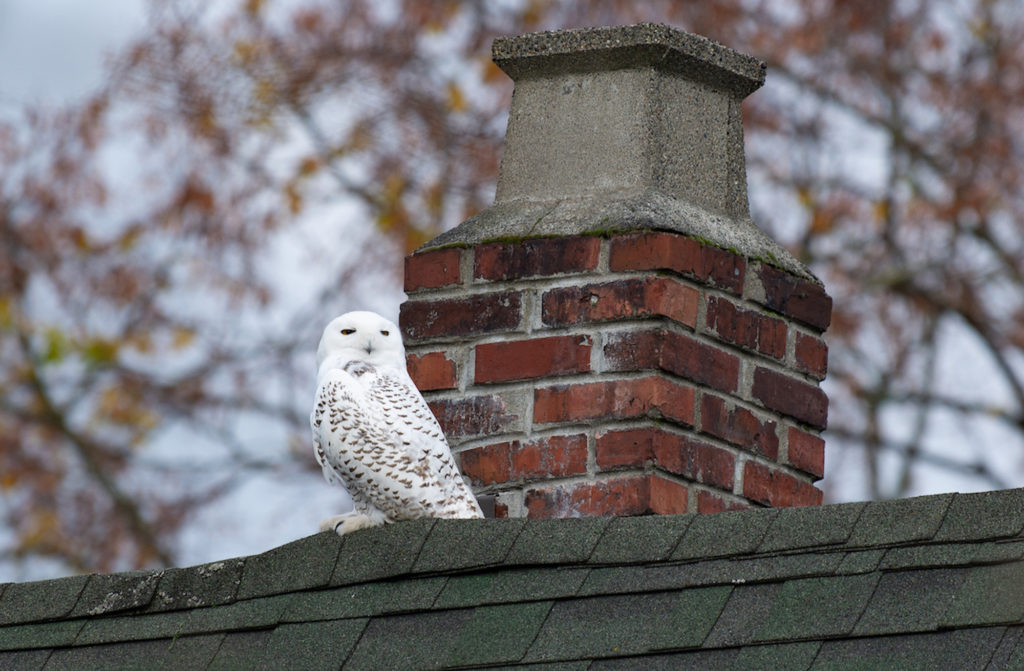Snowy Owl and Raven were both pure white. They decide to make each other more colorful, and Raven paints gray crescents on Owl’s white feathers. But Raven will not sit still while Owl paints him, and in frustration, Snowy Owl pours lamp oil onto Raven, turning his feathers black as night. Transformed, the Raven cries, “Oh, you sharp-clawed, keen-eyed owl, what have you done!” Snowy Owl’s brightness remains unmatched. –Inuit tale.
This instalment of OOTW was inspired by the snowy owl currently hanging around Seattle – more on that later.
These owls are native to the Arctic regions and is found in the circumpolar region, usually breeding about the latitude of 60° north. It is quite distinctive with its white plumage and black feather edges and is one of the largest owls in the world. Males generally are more white with the female’s plumage having more flecks of black.
Bubo – Latin for owl, and scandiacus – Latin for Scandinavia.
Breeding success is highly correlated with the abundance of their main prey item – the lemming a small rodent of the tundra. Fluctuations in lemming availability can lead to mass movements of snowy owls southward – referred to as and irruption. For some time, it was thought that a poor lemming crop was forcing birds south to scour for more prey.
But recent work indicates that during an irruption year the average weight of snowy owls is higher than non-irruption years. Research on their breeding grounds indicate that a strong lemming production year is followed by an irruption south. The thought now is that the birds move south in reaction to a bumper crop of lemmings and the corresponding larger broods of snowy owls. The juveniles then head south seeking their own space.

Snowy owl nest lined with lemmings during a surge in the lemming population.
During these irruptions they have been observed as far south as Georgia, Kentucky, and South Carolina. I think it was the winter of 2011 – 2012 when we experienced a major irruption here in the Pacific Northwest. At one place out near Stanwood I was able to see 5 snowy owls together siting on a berm at the far end of a farm field. The owls were showing up on Capitol Hill and other urban neighborhoods. My favorite sighting that year was in the Woodland Park Zoo, yes – near the snowy owl exhibit.
See more: Irruptions
Males are 20 – 25 inches in length with a wingspan from 4 – 5.5 ft. Males can weigh up to 5.5 lbs. A unique trait of the snowy owl is the long feathers on the foot that cover its talons. As with other owls, they will eat their prey whole, digest the animal, and then cough up a pellet of the indigestible fur and bones. In winter they are opportunistic and while relying on small mammals they occasionally take small birds, such as buffleheads. They have been known to prey upon mammals as large as a red fox.
Nests are simple scratched-out areas on the ground. A late thaw in the arctic can delay and shorten the breeding season and affect clutch success. Clutch size averages 7-9 eggs but up to 15 eggs have been documented for a nest. Incubation will last about 32 days. The male takes on the hunting duties for the first 3 weeks after the chicks hatch and after that the female will join in. Extra prey items may be stored near the nest if the youngsters are not keeping up with what is returned to the nest.

The young birds start wandering around after 3 weeks or so, and their parents will drop food near them. Within 50-60 days the birds are able to fly and begin to hunt on their own. Snowy owls will skip breeding in consecutive years and sometimes will not breed for up to a decade. Studies near Barrow Alaska indicted that snowy owls bred in 13 years over the 23-year study period.
A typical lifespan for a snowy owl in the wild is thought to be about 10 years, while captive birds have lived up to 30 years. Owls, of course, have been revered in different cultures as vessels of wisdom. Even Harry Potter had a snowy owl companion, Hedwig, which, as you remember, was given to him on his 11th birthday by Rubeus Hagrid.

A few weeks ago I noticed some snowy owl sightings in Seattle popping up on bird-watching websites. An owl was consistently found in the Queen Anne neighborhood, a few miles from downtown. So last week, while running some errands around town, we swung by the noted neighborhood. We had pretty good directions on where to go and as we drove slowly down a street noticed a half-dozen folks with binoculars and cameras in an alley. We parked and joined them.
The female snowy owl was sitting on the roof of the house, calmly observing the neighborhood. It is a pretty striking bird to see in an urban area and we felt lucky to get a view of it before it headed to more productive hunting grounds. I’ve included a photo below.
Here’s a couple of websites that will keep you up-to-date on interesting bird sightings – Tweeters is for Washington State: http://birding.aba.org/maillist/WA and eBird is a world-wide source of sightings: https://ebird.org/explore


Hi Jim- I really appreciate the information you shared with us about snowy owls. Like so many other people who live on Queen Anne Hill, I feel so blessed to have had the chance to see her many, many times. She is actually the first owl that I have ever seen in the wild, and I find her fascinating.